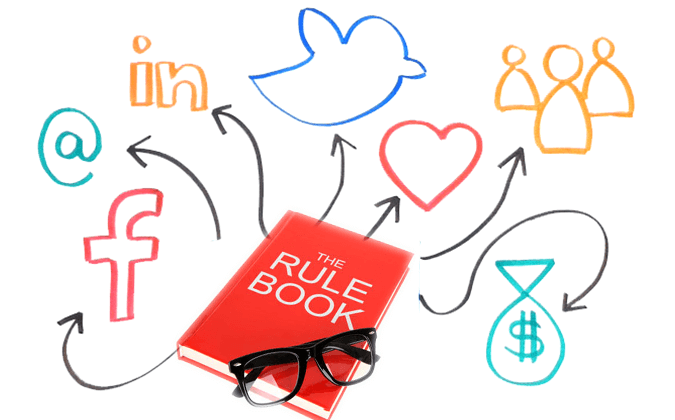One of the major advantages of all the social media is how easy it is for people with similar interests to connect. For example, let’s say you’re a marketing communications person in Seattle. Twenty years ago, would you have had any chance to swap war stories with a colleague in Niigata in real time? Nope. But today, with Twitter, Facebook, Tumblr, LinkedIn, blogs, IM and gaming chat, you can reach out to folks you might never otherwise meet.
This cross channel network can be quite eclectic, which is great. You share and learn about things you might have never seen before. These connections also hold amazing potential value for your company – as well as potential risks.
The Delicate Work/Personal Social Media Dance
Let’s say you aren’t happy at your job, but your boss strongly “encourages” you to Tweet and Facebook about a new product release. At best, your connections and tweeps might think you are insincere or just talking corporate speak. At worst, you may actually come off insincere or negative, both hurting your job security and your personal credibility.
But many companies are trying to extend their social media reach via their employees. This is a valid request and strategy, as you can vastly increase your audience via your employees. And if you have a strong culture of happy employees, this can bring wonderful engagement and a large audience for your message.
So how do you balance this both as an employee or someone managing social media?
Here’s 6 steps you can take personally and/or as a social media manager.
1. Focus on Happy Employees Over Social Media Posting
I personally find it off-putting when a company leans on their individual contributors to use their own personal Twitter accounts, Facebook pages, Tumblr blogs and the like to advocate for a new product.
I have found that if your people are excited about the company and the product, they’ll do that on their own. And when they do, their enthusiasm will shine through.
So, I strongly advise against forcing your folks to post about new releases or company announcements. Remind folks, sure; we all need a reminder now and again. But many, maybe even most, of your team created those accounts for themselves, and may resent being asked to use them for the company’s benefit.
It’s not unlike the time one of my cousins brought a bunch of knick-knacks to a family Thanksgiving dinner, trying to get us to buy them. Everyone was uncomfortable. You don’t want to be the awkward cousin at the feast.
2. Create Clear Social Media Guidelines for Employees
It’s hard for employees to know how to amplify your company posts if you don’t provide the guidelines and suggestions for them to follow. Make sure you have clearly written policies and rules of the road. Show examples of how to post on different networks. And remind them of your PR guidelines why you are at it.
For example, if a journalist starts a conversation on Twitter with you, contact your PR manager, so your tweet does not show up in the next article :-).
3. Provide Pre-Written Posts and Images
Make it easy for employee to help augment your message by creating pre-written tweets and posts. They can always personalize them if they want, but the easier you make it for them to post something (and stay within guidelines), the more likely they will be to actually do it.
4. Use Separate Accounts for Work and Personal Personas
One strategy some people use is creating separate accounts specifically for work-related information or for personal connections. This can work if you feel uncomfortable pulling work-related stuff into your personal social media spaces and want to create work-only spaces.
This does not have to mean you have two Twitter accounts. You might just use the different networks in different ways. For example, work stuff on LinkedIn and Twitter, personal stuff on Facebook and Instagram.
Regardless of how you balance this, make sure you are not being completely different across your work and personal social media personas.
You still need to be “you” on all social media. So, don’t overdo the corporate mode on your professional social media handles, and don’t get too personal, rude, opinionated or foul mouthed on your personal social handles.
As I like to remind my children, what you say on Facebook can be found, even if you think potential employers will only read your Twitter feed.
5. Target Your Message, but Don’t Assume
In a similar vein, it’s important to target your information to people you know will find it interesting but not to assume only they will be interested.
People are following you because of who and what you are. Whether friends, colleagues, gamers, schoolmates or people you met through your network, they pay attention to you or connect with you based on their relationship with you, a mutual interest or because they just like what you have to say.
Take time to target your message to who (and what channel) would find it most interesting. When you have a piece of info or something you believe will be interesting to a particular audience or subset of your social media list, make sure they know about it.
For example, when I am talking about marketing-specific topics, I cc my (virtual) friend A.H., knowing not only will he probably find it interesting or at least give it a look, he may very well re-tweet it to his own list of followers, expanding my reach!
Same goes for the posts you publish for your company. Take time to make sure your message fits your audience.
6. Enjoy the Network Effect
Whatever you do, have fun with it.
This is an opportunity to break out of your “echo chamber”, your “bubble”; the insular world we all sometimes get into at work.
So for example, there are an endless list of issues I have faced repeatedly in my time creating content in high tech over the last 20+ years. But while these issues may be old and tired for me, that’s not necessarily true for many people on my various social media lists.
My Uncle, living on an island for the last 30 years, may not know a lot about high bandwidth home networking options. My friend the psychologist and traditional medicine practitioner is probably unaware of some of the advantages he might find in using the cloud to store his patient data. My engineer friend in Montana may actually be surprised about the advantages I’ve found when content and marketing teams work together. And on and on.
And you never know what might peak someone’s interest, and when they might re-tweet, or re-post, or just link to your information, exposing it to their eclectic network of friends. And that gets your info out of your local bubble.
Time to Tango!
As you think about how much and what work items you want to amplify via your personal social media handles, here’s some things to keep in mind:
- Don’t be afraid to post about your work stuff on your personal accounts
- Do be careful to not sound like a shill; find a good balance between enthusiasm and annoying boosterism
- Don’t force your folks to post company stuff via their personal accounts; suggest it when appropriate
- Do provide guidelines and pre-written posts to make it easy for those who do want to share with their connections.
- Do target your posts/tweets/etc. appropriately
- Do enjoy yourself – after all, social networks are there for fun (in addition to hard work!)
Yes, it’s a little extra work, but in the end will pay off. So get out there and use your social media accounts, and provide the encouragement and structure to your employees who can/will extend your messages.





